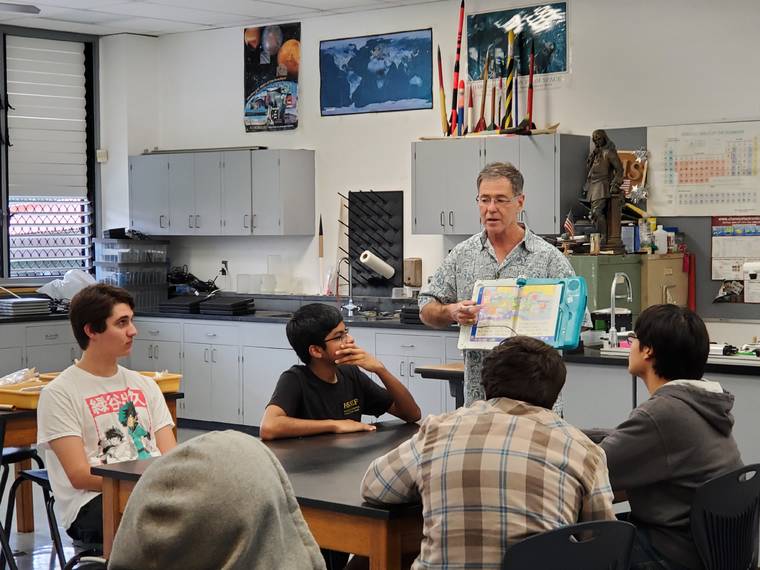Inventor of LeapPad speaks to Waiakea High students

STEPHANIE SALMONS/Tribune-Herald Inventor and entrepreneur Jim Marggraff, who invented the LeapPad Learning System and the first smartpen, spoke to Waiakea High School students on Thursday.
Who here is an entrepreneur, or will be in the future? Jim Marggraff asked a small group of students gathered after school last Thursday at Waiakea High School.
“Who here is an entrepreneur, or will be in the future?” Jim Marggraff asked a small group of students gathered after school last Thursday at Waiakea High School.
A few raised their hands.
ADVERTISING
“Is anyone an inventor, or would like to be?”
“I’d like to be,” one student responded.
About 20 Waiakea High STEM students got a lesson from Silicon Valley when Marggraff, a prolific inventor and entrepreneur in his own right, and his wife MJ Marggraff spoke to the group.
Jim Marggraff is a graduate of Massachusetts Institute of Technology who has founded and co-founded several companies, including Livescribe, Explore Technologies and Eyefluence, which was purchased by Google in 2016. He also invented the LeapPad Learning System and the world’s first smartpen.
According to her website, MJ Marggraff is a commercial pilot, author and creator of GravityGames, a STEM program for high school students that aims to promote the understanding of zero-gravity, space manufacturing and astronaut life on the International Space Station.
Jim Marggraff said he started inventing as a boy but it “really took off” after he went to school. He spoke of the challenges he faced as an inventor and how students can overcome similar obstacles.
When he first had the idea for LeapPad, an interactive learning system for children, Marggraff said he was able to secure a meeting with the president of Toys “R” Us.
“I said ‘Here it is. Here’s my idea,’ and I was expecting him to say ‘Oh, this is great,’ but what he said was ‘That’s a good idea, but it’ll never sell,’” he told the students.
Marggraff said he then started asking other people, but kept getting similar responses — that the idea won’t work and won’t sell — but he kept pushing and asking questions.
“I pushed and I asked and I thought about it, kept doing prototypes,” and eventually he met the president of LeapFrog, the company that manufactures the learning system.
The LeapPad system eventually made more than $1 billion dollars in sales.
“From 1999 to 2004, we helped about 100 million kids around the world from an idea that people said it’s crazy, it’s impossible, won’t work, people don’t want it, they’re not going to use it,” Marggraff said. “So I tell you that because as you start thinking about the robotic ideas you’re going to have, you’re going to start working on your projects … and for those that go further that are thinking about inventing, you’re going to find that when you have an idea, few people will say ‘that’s really cool.’
“Maybe you’ll build a little prototype, but then when you try to push it further, and try to solve the harder problems, the challenges that you will have is you will find many people that will say why it won’t work,” he continued. “In fact, the crazier the idea is, the more outrageous, the more difficult it is to do … you’ll have more push back.”
Marggraff told the students there are two words he wants eliminated from their vocabulary: “can’t” and “impossible.”
“When you reach that point where it looks like you (can’t), and somebody says to you ‘it’s (impossible), most people will at that point just pull back and they’ll throw their arms up and they’ll give up,” he said. But if you talk to any entrepreneur, “the number of they’ve been told the word ‘can’t’ (or) ‘impossible’ over and over is uncountable.”
When they get stuck, Marggraff said the students should focus on the problem they’re trying to solve and ask questions.
“I feel like honestly it’s life changing being this young and being able to make connections with people in the positions that they are … being able to call themselves an inventor and work with the International Space Station,” senior Alannah Shinde said.
That experience is “everything” for students “to see what’s possible and what we are capable of,” she said. “I feel like it really brings the inspiration for my peers and me as well.”
For Shinde, the best part of the discussion was hearing what the Marggraffs have experienced and created.
“I feel like it only widened how (big) I thought the inventing world is and how I could even be a part of that.”
Physics and engineering teacher Dale Olive said the talk was motivational.
“I like that it validates what we talk about in class because these are my engineering kids,” he said. “The process they went through to solve a problem, that’s the same thing we’re going through over and over again.”
Olive said, too, the Margraffs are role models.
“And I think my kids, looking at them, I can see that, where they’re going ‘wow, I want to be like that.’” he said. “So it’s a wonderful opportunity to have them here to present something like that. As a teacher, I loved it.”
Email Stephanie Salmons at ssalmons@hawaiitribune-herald.com.


